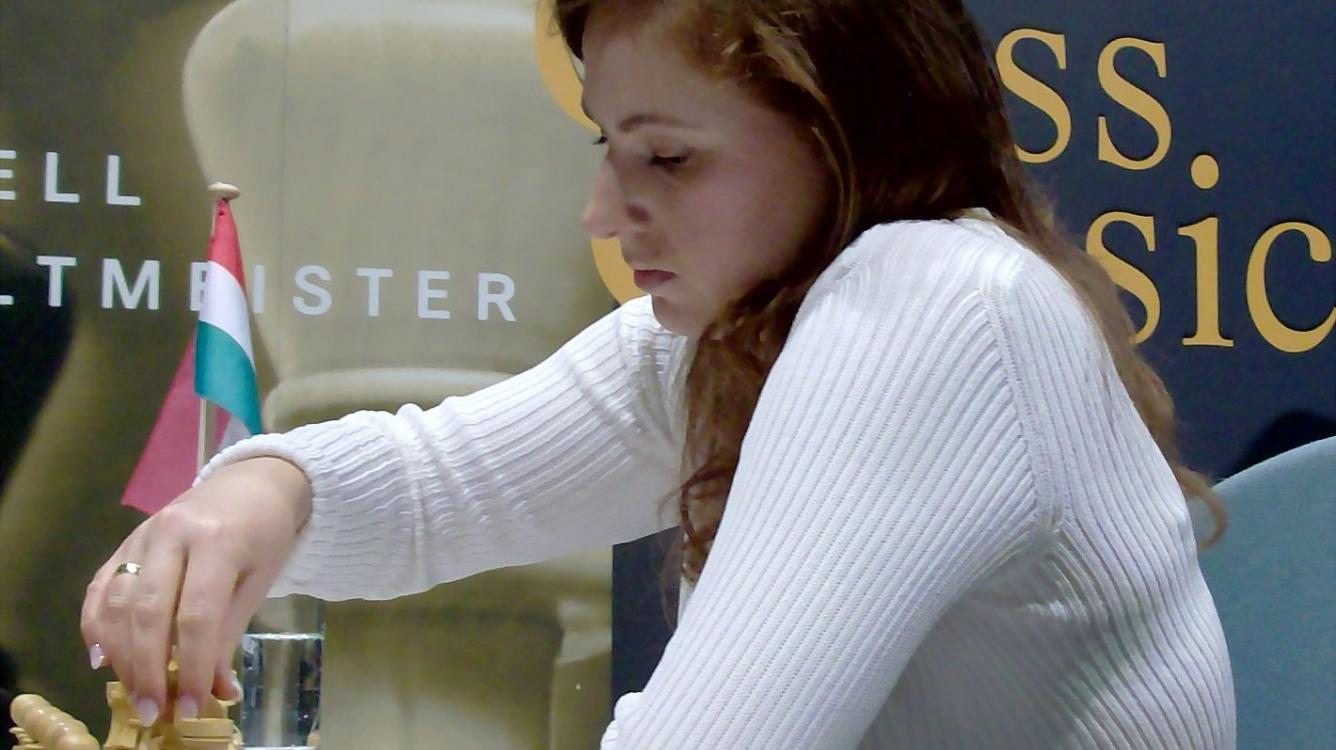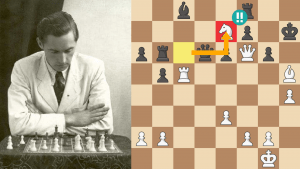
Cracked Grandmaster Tales: Polgar vs Silman
I didn’t intend to write a 4th Cracked Grandmaster Tales article, but so many Chess.com members asked me to do another that I decided to share a few more (true) stories. I hope you enjoy these as much as you did the others. Be warned: there might be a second encore after this.
SILMAN DRAWS A LITTLE GIRL
New York 1988. I was paired with the most popular player in the event, 12-year-old Judit Polgar. She was doing well against strong opposition (including grandmasters) and I was supposed to be her latest victim. What made things particularly unpleasant was that dozens of Judit fans were watching and they wanted blood...MY blood!

The battle begins
Of course, I was older, more experienced, and fully expected to win.
Nowadays I would have played on since Black is doing well. However, the game was hard on the nerves (especially with the hostile crowd surrounding me) so I was happy to draw and escape the masses!
Afterwards we went to the skittles room to analyze the game. I expected a quiet, shy little girl that would listen intently to my “grown up” ideas. Instead, she took over the analysis! Her hands tossed the pieces here and there with amazing authority, and her comments made it clear that she was the one that fully expected to win and I was somehow fortunate to have survived!
It was only then that I realized that she was going to rock the chess world.
Oddly, I ran into all three sisters in Mazatlan that same year.

The last time I saw Judit was at the Melody Amber tournament of 1994. The photo (sorry, it’s rather poor quality) shows Judit, Seirawan, and myself at a table with me raving (as usual).

Silman raves while Judit and Yaz look on
I AM TAUGHT A LESSON AT INDIAN CHESS
(This story has nothing to do with grandmasters, but I think you’ll find it enjoyable.)
Though Europe embraced castling in the 15th and 16th centuries, India stuck to its own version (no castling allowed and a pawn can’t move two squares on its first move) for quite a while (as late as the 18th and 19th centuries!). I had heard that some Indian players still stick to the old rules but I didn’t believe it. However, while in Delhi (I’m not sure of the date. Perhaps 10 years ago) I was checking out various shops and noticed several chess sets on display in one of them.
I was going to walk by but my wife and friends insisted I enter. The owner showed me the sets and before I knew it challenged me to a game. I thanked him and tried to escape, but my compatriots wouldn’t take no for an answer. Giving in, I quickly set up the pieces and the game was on!
1.e3
I smiled and thought, “This guy is awful. The game won’t last long.”
1...e5
My opponent looked at me as if I were a complete imbecile and said, “That’s illegal. Pawns can only move one square at a time. You don’t know Indian chess, do you?”
I shook my head, shrugged, and put the pawn back on e7. My opponent once again spoke: “No, no! Touch move! You must put the pawn on e6.”
1...e6 2.g3 e5
I was stubborn.
3.Bg2 Nf6 4.Nh3 d6
After this move my opponent spoke again: “You do know how to move your king, right?”
My first thought was, “Oh god, what’s he going to say next?”
He continued, “The king can move like a knight once in a game. You really need to learn how to play this game.”
I thought he was cheating and I blurted out, “Give me a break! I intend to move my bishop to e7 and then castle.”
He glared at me again. “Tsk. There’s no such thing. You either move your king one square in any direction or you use your one-time-only knight move.”
I started laughing. “Really? You’re joking, right?”
His stony look made it clear that he was dead serious.
5.b3 c6
I was very happy with this move. I thought, “If you can’t beat them, join them!”
6.Bb2
Now, with a huge smile, I moved my king to c7, making use of the “king can move like a knight once in a game” rule.
6...Ke8-c7!!!
Our eyes locked, he smiled, and the game continued. The following photo captures that exact moment.

My opponent points, as if to say, “THAT is the way a king castles!”
I left thinking that the gentleman was making things up and toying with me. Imagine my surprise when I read that in the old “Indian Chess” the king CAN move like a knight once in a game (!), that castling isn’t allowed, and that pawns can only move one move at a time even if the pawn hasn’t moved (no two-move rule).
Live and learn!
THE GREATEST CHESS STORYTELLER OF ALL TIME

Growing up I had lots of chess heroes. However, the ones that were still alive were Tal, Fischer, Petrosian, and Bent Larsen (now, sadly, all deceased). Naturally I studied all their games and followed every event they were in.
In my earlier Cracked Grandmaster articles I mentioned how I was lucky enough to meet Tal and Petrosian, and though I only saw Fischer from afar (never spoke face to face with him) I did have some strange/unfortunate “Fischer moments” (e-mail and a disturbing phone call to Benko’s apartment in Budapest while we were waiting to meet Bobby for dinner) that I don’t wish to get into.
The fourth hero was the amazing Danish player Bent Larsen and I was very fortunate to meet him when he visited Southern California (around 1990). During the mid-60s (where he won tournament after tournament ahead of the world’s finest players) it wasn’t clear who was the best non-Soviet player in the world -– Fischer or Larsen. All conjecture ended when Fischer beat Larsen 6-0 in their 1971 Candidates semifinal match.
To give you a glimpse as to how strong Larsen was, he beat Petrosian 2-0 in the legendary Second Piatigorsky Cup. Here’s one of those games:
Larsen also beat Tal in a 1969 Candidates match by a dominating score of 5.5-2.5.
Bent Larsen wasn’t just one of the world’s best chess players, he was also one of the world’s finest chess writers. He wrote with energy, wit, authority, and depth. I view his book, “Larsen’s Selected Games of Chess (later reprinted and named “Bent Larsen Master of Counter-Attack," and then expanded by New in Chess with the name: “Bent Larsen’s Best Games”), to be one of the best chess books ever.
Ed Labate and I spent several hours with Bent at a restaurant, and the “great Dane” regaled us with one incredible story after another. It was one of those experiences that you don’t want to ever end.
Bent eventually discussed his match with Fischer. He was still angry that Fischer had (“illegally”) been given a berth in the 1970 Interzonal (Benko gave his spot to Fischer). Fischer won that event with 15 wins, one loss, and seven draws (3.5 points ahead of the field), while Larsen tied for second with Geller and Huebner (15 points out of 23 games). Fischer’s one defeat: to Larsen!
I was sad to hear that, after so much time had passed, he never really got over his 6-0 defeat. The fact is that Larsen fought to win every game, and all the games were incredibly combative so he had nothing to be ashamed of. Nevertheless, it’s impossible for a proud and supremely confident man who truly felt he was the best in the world to accept a 6-0 drubbing, and (though he had some impressive successes in the early to mid 1970s) he was never able to regain the same enormous level he repeatedly showed before the match.
Here’s one of the stories he told me during that dinner:
Grandmaster Friedrich Samisch (1896-1975) had just gotten married and, after the honeymoon, the newlywed couple returned to Samisch’s home. Hoping to relax after the festivities, his wife was cooking a nice dinner when Samisch noticed a letter on the floor. It turned out that it was an invitation to a very strong tournament, so Samisch told his wife that he had to participate and off he went (the dinner still cooking!), leaving her behind.
Two months later he returned, his two huge travel cases in tow. His wife rushed up to him, delirious with joy. She told him to relax, that she would make him a welcome-home meal, and he could tell her all about his adventures. Samisch sat back, happy to be reunited with his bride. Then he noticed a letter on his desk. It had been sent a couple of weeks earlier and it was inviting him to a wonderful event with many of the world’s best players.
Leaping up, he said, “Another invitation. If I leave now I can just barely make it!”
Since his bags were still closed and had everything he needed, he grabbed them, gave his wife a kiss, and rushed out. Two months later he returned home only to find that he no longer had a wife.
Larsen and I stayed in touch after the dinner, and I did my best to persuade him to write more books. Unfortunately, things didn’t work out and, in 2010, he died in Buenos Aires at the age of 75.
A COLD WAR MOMENT

Bratislava, Slovakia, 1993. I was the head of the American delegation for the World Youth Chess Championships. The person in charge acted like the Cold War was still alive and well, and felt he could rule with an iron fist. When I arrived (to the usual total chaos), I found that they used popsicle-sticks to show the coaches’ and players’ names. Various delegations were complaining about outrageous fines.
I noticed that Pal Benko’s name was on top of the American popsicle ladder (signifying that he was the head of the delegation). I told Mr. Cold War that he had made a mistake and that I was in charge of the American teams, with Benko taking up the rest of the coaching responsibilities. Mr. Cold War said, “This is a serious matter! We have to give you a fine of $1,000 since it will take time to fix this error!”
I looked him in the eye, took Pal’s popsicle-stick off the board, placed mine on top and Benko’s below me, smiled and said, “Problem solved!” Then I walked away.
The coaches and players stayed in a couple of hotels, and we had a problem. The USCF had promised to wire Benko the money for his hotel stay after forgetting to pay for his hotel room ahead of time, but it didn’t do so. I contacted the USCF when we realized that Benko was sent adrift by our federation, and the USCF once again promised that it would wire it in a couple days.
Days passed, Mr. Cold War did his best to make everyone’s life a misery, and poorer teams had relatives attend, which meant some rooms had five or six people stuffed inside a space designed for two. The actual players would go down for breakfast (which was free for the participants), where they would fill backpacks with food for those hiding in the rooms.
The hotel was freaking out due to Benko’s inability to pay his bill (credit cards were rare at that time and the hotel refused to accept them), and it became clear that the USCF, which was incredibly incompetent in those days (hopefully they’ve improved) had screwed us again.
Here’s what I wrote in Pal Benko’s Life, Games, and Compositions:
“Finally, with just one day left and payment past due, I was forced to enact a scene right out of an old spy movie: Four in the morning, a cab pulls up to the curb and patiently waits two blocks from the hotel. I quietly lead a lone figure through the hotel’s halls and out the back door. Having successfully made our exit, I drag the horrified grandmaster to the waiting cab, which streaks him away to the Vienna airport and a successful escape. When the organizers eventually realized that something was amiss, I just played dumb and shrugged my shoulders. Such intrigue wasn’t part of the job description, but a coach has to be ready for any eventuality!”



